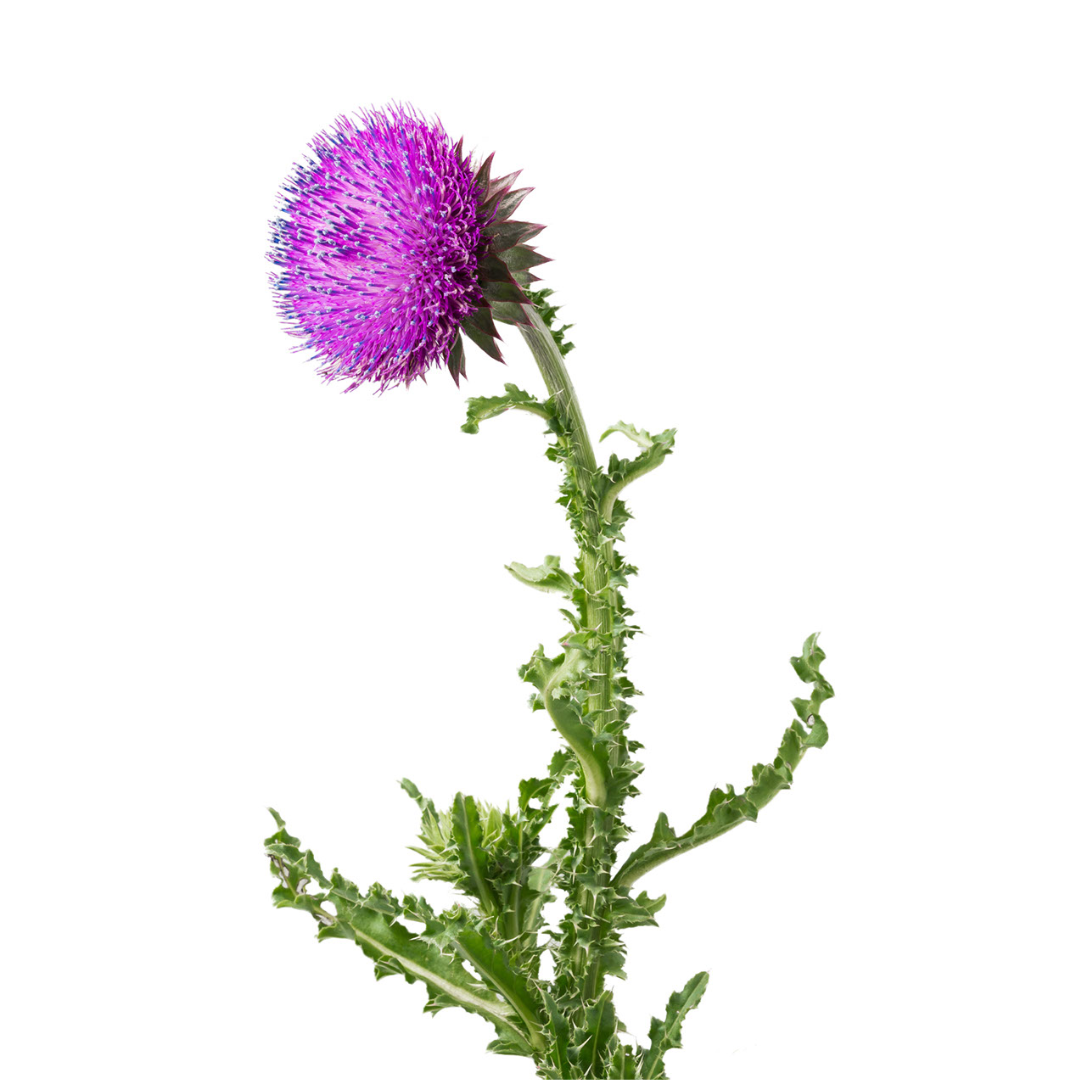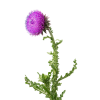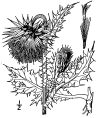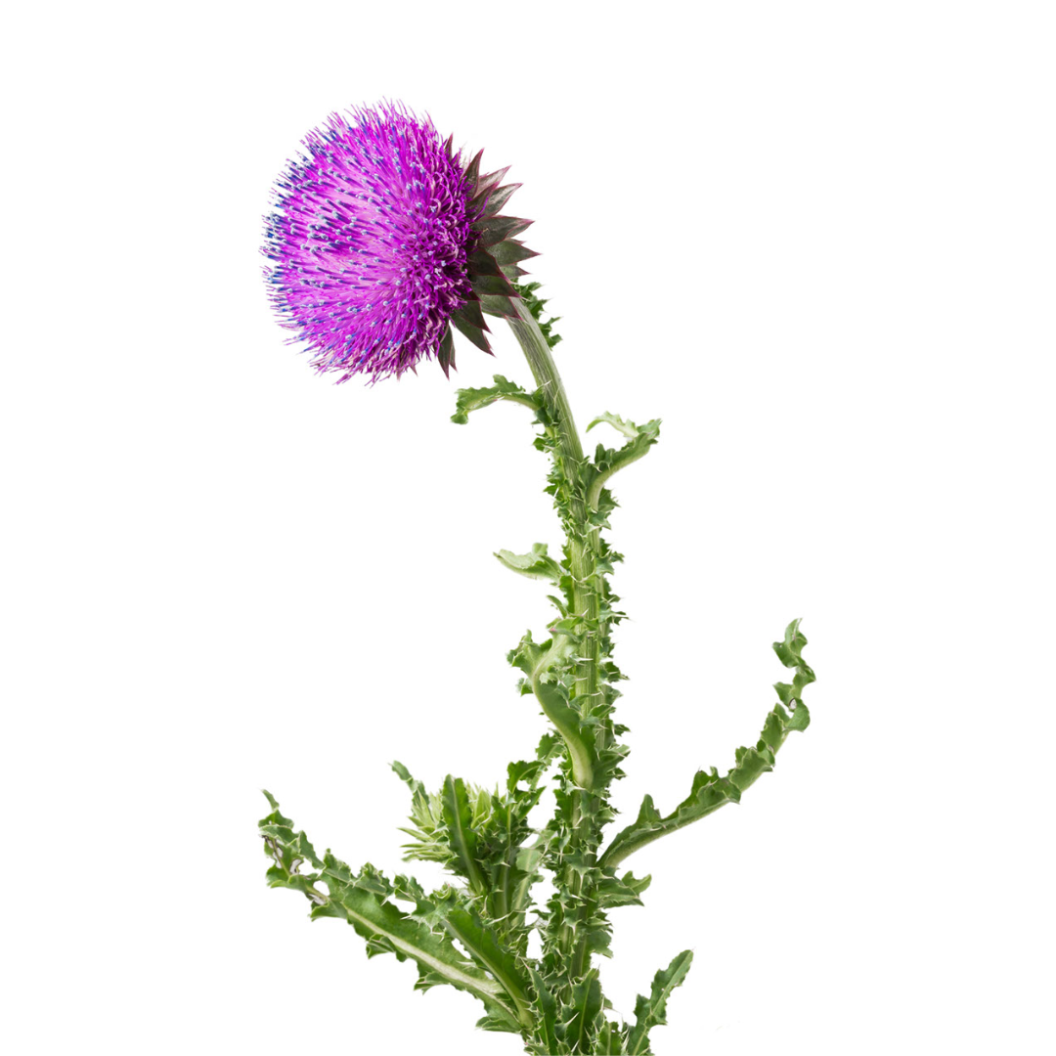




Musk Thistle
DESCRIPTION: The musk thistle is a spiky plnat that can grow up to 6 feet tall. It has pink or purplish flowers that bloom in summer and give of a distinct, musky smell. The leaves, although prickly to the touch, are quite pretty, with a silvery-green color and intricate patterns. This plant is considered a weed due to its ability to completely take over fields and gardens, making it difficult for competing plants to grow.
SCIENTIFIC NAME: Carduus nutans
OTHER NAMES: Nodding Thistle, Nodding Plumless Thistle, Nutans Thistle, Nodding Carduus
LEAF TYPE: Broadleaf
FLOWERS: The musk thistle has large, showy flowers that are usually pink or purple in color. They are shaped like spiky balls, and each flower is made up of many tiny individual flowers clustered together. The spiky ball of flowers at the end of a long stem can be up to 2 inches in diameter. The flowers bloom in the summer and have a distinctive musky fragrance. They are very attractive to bees and other pollinators.
LEAVES: The leaves of the musk thistle are quite large and have a unique, spikey shape. They are typically a silvery-green color and can be up to a foot long, with a wavy, lobed edge. The leaves grow in a circular pattern at the base of the plant. The surface of the leaves is covered in tiny, spiny thorns, which can make them painful to touch. Despite their prickly appearance, the leaves have an interesting texture and pattern that makes them a visually attractive feature of the plant.
LIFE CYCLE: Annual & Biennial
HOW TO IDENTIFY: The easiest way to identify a musk thislte is to look for a plant that is tall and has a large, showy pink or purple flower shaped like a spikey ball. The flowers will have a musky smell and bloom in the summer. The leaves will be in a circular rosette pattern at the base of the plant and are silvery-green with a spikey, lobed edge. They will be covered in tiny, spiny thorns. Obvserve from a distance as touching the leaves of this plant will prove to be extremely painful.
MECHANICAL CONTROL RECOMMENDATIONS:
1. Mowing - More Info
2. Cutting - More Info
3. Hand Pulling - More Info
4. Tilling - More Info
5. Grubbing - More Info
6. Prescribed Grazing - More Info
7. Biocontrol - More Info
8. Cover Crops - More Info
9. Mulching - More Info
CHEMISTRY RECOMMENDATIONS:
"Pre-emergent herbicides:
Aminopyralid: Aminopyralid is known for its effectiveness against certain broadleaf weeds, including musk thistle. It is available in various formulations and can provide residual control of emerging weeds.
Picloram: Picloram is a long-lasting pre-emergent herbicide that has been used for controlling musk thistle and other tough-to-control broadleaf weeds.
Clopyralid: Clopyralid is effective against many broadleaf weeds, including musk thistle. It is often used in pasture and range settings.
Triclopyr: Triclopyr is another broad-spectrum herbicide that can provide pre-emergent control of musk thistle. It is available in various formulations.
Imazapic: Imazapic is often used for controlling broadleaf weeds in rangeland and non-crop areas. It can provide pre-emergent control of certain weed species, including musk thistle.
Indaziflam: Indaziflam is a newer pre-emergent herbicide that can provide residual control of several weed species, including some broadleaf weeds. It is known for its extended soil activity.
Isoxaben: While more commonly used for controlling annual grasses, isoxaben can also provide some pre-emergent control of certain broadleaf weeds.
Post-emergent herbicides:
2,4-D: 2,4-D is a widely used herbicide for controlling broadleaf weeds. It can be effective against musk thistle when applied during the plant's active growth stage.
Clopyralid: Clopyralid is known for its effectiveness against tough-to-control broadleaf weeds like musk thistle. It's often used in range and pasture settings.
Aminopyralid: Aminopyralid is another herbicide that is effective against many broadleaf weeds, including musk thistle. It provides good control and can be used in various settings.
Glyphosate: Glyphosate is a non-selective herbicide that can effectively control musk thistle. It's important to note that glyphosate will also kill desirable plants, so use it with caution and only in appropriate areas.
Dicamba: Dicamba is a selective herbicide that targets broadleaf weeds. It can be effective against musk thistle and is often used in combination with other herbicides.
Triclopyr: Triclopyr is known for its control of many woody and broadleaf weeds. It can be used to target musk thistle, particularly in areas where you want to avoid killing grasses.
Fluroxypyr: Fluroxypyr is effective against a range of broadleaf weeds, including musk thistle. It's often used in pasture and rangeland settings.
Metsulfuron-methyl: This herbicide is used to control a variety of broadleaf weeds, including musk thistle. It can provide good control with relatively low application rates.
Clopyralid + Triclopyr Mixtures: Some herbicide products combine clopyralid and triclopyr to provide a broader spectrum of weed control, including musk thistle.
Selective herbicides:
Clopyralid: Clopyralid is known for its selective control of broadleaf weeds like musk thistle. It's commonly used in pasture and range settings where grasses are desired.
Metsulfuron-methyl: This herbicide is effective against many broadleaf weeds, including musk thistle, while being relatively safe for grasses. It's often used in pasture and rangeland management.
Aminopyralid: Aminopyralid provides good selective control of many broadleaf weeds, including musk thistle. It's used in various settings where grasses need to be protected.
Triclopyr: Triclopyr is often used to selectively control woody and broadleaf weeds, making it suitable for managing musk thistle in grassy areas.
Fluroxypyr: Fluroxypyr is effective against a range of broadleaf weeds, including musk thistle, with minimal impact on grasses.
Dicamba: Dicamba is a selective herbicide that targets broadleaf weeds. It can be effective against musk thistle and is often used in combination with other herbicides.
Chlorsulfuron: Chlorsulfuron is used to control a variety of broadleaf weeds, including musk thistle, while being relatively safe for grasses.
Picloram + 2,4-D Mixtures: Some herbicide products combine picloram and 2,4-D to provide selective control of broadleaf weeds, including musk thistle, in grassy areas.
Non-Selective herbicides:
Glyphosate: Glyphosate is one of the most widely used non-selective herbicides. It's effective against many weeds, including musk thistle. However, it will also kill desirable plants, so use it with caution and only in areas where you want complete vegetation removal.
Glufosinate-ammonium: Glufosinate is another non-selective herbicide used for broad-spectrum weed control. Like glyphosate, it should be used carefully to avoid damaging desirable vegetation.
Paraquat: Paraquat is a fast-acting non-selective herbicide that causes rapid desiccation of plants. It's often used as a burndown treatment to prepare fields for planting.
Diquat: Diquat is another non-selective herbicide used for burndown purposes. It's contact-based and causes rapid desiccation of plant tissues.
Pelargonic Acid (Nonanoic Acid): This is a non-selective herbicide derived from fatty acids that can be used for contact-based weed control. It causes rapid cell membrane disruption and tissue desiccation.
Recommended Prevention
Recommended Control

